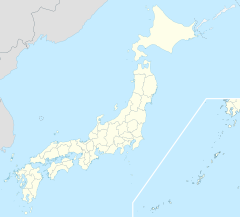Tomioka Hachiman Shrine
| Tomioka Hachiman Shrine 富岡八幡宮 | |
|---|---|
Kōtō, Tokyo, Japan | |
| Geographic coordinates | 35°40′18.31″N 139°47′58.50″E / 35.6717528°N 139.7995833°E |
| Architecture | |
| Date established | 1627 (Kan'ei 4) |
| Website | |
| www | |
Tomioka Hachiman Shrine (富岡八幡宮, Tomioka Hachimangū) is the largest Hachiman shrine in Tokyo.[1]

History

The shrine was established in
During the
On 10 March 1945, the shrine was burned down during the
It is far more tragic feeling in case of this time. Concrete remains etc. pain my heart further. It is miserable. Grand chamberlain! Tokyo also became a burnt ground at last by this.
After the war, two stone monuments to commemorate the visit were built in precincts.[citation needed]
In June 2017, the shrine decided to leave the control of Association of Shinto Shrines.[3]
On 7 December 2017, the chief priestess of the shrine, Nagako Tomioka, was stabbed to death, reportedly by her brother Shigenaga Tomioka. The attacker's wife also took part in the attack according to the police, injuring the priestess' driver. Her brother later stabbed his wife to death before committing suicide. A bloodied sword and knives were found at the scene.[4]
Sumo

Tomioka Hachiman Shrine is also known as the birthplace of Kanjin-zumō (勧進相撲), founded in 1684 and origin of the current professional sumo.[5]
Two
In 1900 (Meiji 33), the stone monument to commend successive
Thus, when a
References
- ^ 富岡八幡宮:御由緒 (in Japanese). Tomioka Hachiman Shrine. Retrieved 2008-08-12.
- ISBN 9780810874893.
- ^ 神社本庁「恐怖政治」の実態、地方の大神社で全面戦争も、週刊ダイアモンド、2017年7月5日。
- ^ "'Samurai sword' attack leaves three dead at Tokyo shrine". BBC. 7 December 2017. Retrieved 7 December 2017.
- ^ "Fukagawa Koto-ku Guide - Tokyo". Japan Visitor. Retrieved 2008-08-12.
External links
- Tomioka Hachiman Shrine official website - (in Japanese)

